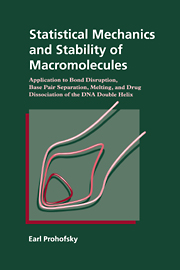 Statistical Mechanics and Stability of Macromolecules
Statistical Mechanics and Stability of Macromolecules Book contents
- Frontmatter
- Contents
- Preface
- 1 Introduction
- 2 Macromolecular stability
- 3 Lattice dynamics
- 4 Effective phonon theory
- 5 Premelting disrupted chemical bonds
- 6 Cooperative melting
- 7 Strained chemical bonds: salt and pressure effects
- 8 Bond disruption and conformation change: B to Z conformation change in DNA
- 9 Hydration effects: structural water
- 10 Helix with daunomycin intercalated: increased helix stability and daunomycin-DNA binding constant
- 11 Nonrepeating DNA
- 12 Cutting and splicing: junctions, inserts, and the replicating fork
- 13 Interaction between a helix and a single attached molecule
- 14 Energy considerations in bond opening
- Appendix 1 Helical lattice dynamics
- Appendix 2 Density matrix and effective phonon theory
- Appendix 3 Green functions
- References
- Index
13 - Interaction between a helix and a single attached molecule
Published online by Cambridge University Press: 16 September 2009
- Frontmatter
- Contents
- Preface
- 1 Introduction
- 2 Macromolecular stability
- 3 Lattice dynamics
- 4 Effective phonon theory
- 5 Premelting disrupted chemical bonds
- 6 Cooperative melting
- 7 Strained chemical bonds: salt and pressure effects
- 8 Bond disruption and conformation change: B to Z conformation change in DNA
- 9 Hydration effects: structural water
- 10 Helix with daunomycin intercalated: increased helix stability and daunomycin-DNA binding constant
- 11 Nonrepeating DNA
- 12 Cutting and splicing: junctions, inserts, and the replicating fork
- 13 Interaction between a helix and a single attached molecule
- 14 Energy considerations in bond opening
- Appendix 1 Helical lattice dynamics
- Appendix 2 Density matrix and effective phonon theory
- Appendix 3 Green functions
- References
- Index
Summary
Separate element approach
Biological processes on the helix are often carried out by specialized molecules that attach to the helix. The attachment is often soft, by nonbonded and H-bond interactions rather than by valence bonding. The nonbonded interactions by themselves tend to cause a less specific attachment to the helix, i.e. they allow movement along the helix and are not necessarily to particular positions on the helix. The more specific interactions to particular sites seem to involve specific H-bond interactions. To a large extent the attached molecules and the helix retain their individual identities in the sense that they are strongly bound internally by valence bonds but more loosely coupled to each other by H-bonds and nonbonded interactions. The dynamics of such a system can be efficiently studied by the splice methods developed in the previous chapter. No calculations of the interaction of a whole molecule with a helix have been carried out as yet except for the case developed in Chapter 10. This discussion will describe a partial calculation of greater generality which explores the effect of some parts of a whole molecule interacting with a helix and displays how calculations with a more complex whole molecule may be done.
The method discussed here is complimentary to the calculations in Chapter 10. There one assumed that a large number of the molecules were attached to the helix in a way that retained overall helical symmetry.
- Type
- Chapter
- Information
- Statistical Mechanics and Stability of MacromoleculesApplication to Bond Disruption, Base Pair Separation, Melting, and Drug Dissociation of the DNA Double Helix, pp. 173 - 180Publisher: Cambridge University PressPrint publication year: 1995
